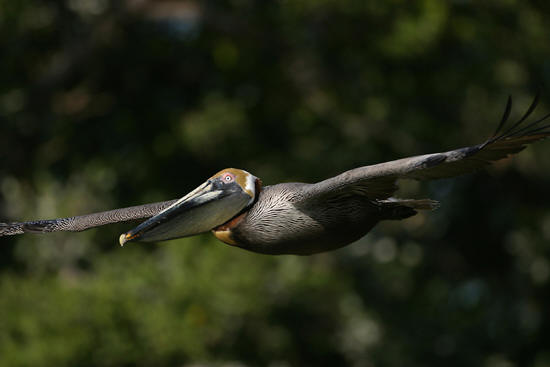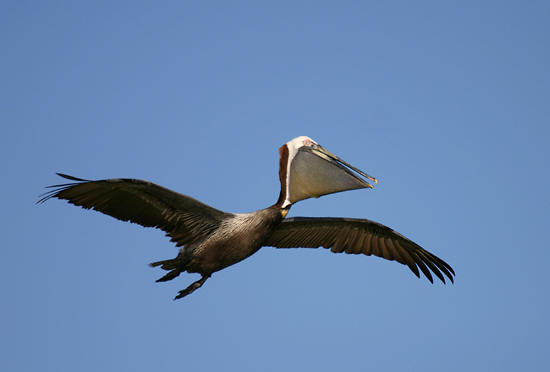Arthur Morris / Birds as Art
Bulletins and Notes Archive
Click any image to enlarge it
|
Bulletins and Notes Archive
|
BIRDS AS ART ON-LINE Bulletin #103 April 23,
2003
FIELD REPORT
ON CANON EOS D10
PIXELS TO
PRINT
CHICAGO BIRDS
AS ART PHOTOGRAPHY WEEKEND
Sandhill Crane, grown chick, Indian Lake Estates, FL
Canon EOS 10D, 100-400mm IS L zoom lens, handheld.
ISO 400. Evaluative Metering -1/3 stop =
1/200 sec. at f/9.5, pop-up flash at 0
Image copyright 2003 Arthur Morris/BIRDS AS ART
The EOS 0 D and the 1-4 zoom yield a deadly
160-640mm handholdable lens...
FIELD REPORT: THE CANON
EOS D10
Recently, thanks to the generosity
of Hal Dupont of Vero Beach, I had the opportunity to field test
a Canon EOS 10D. The 10D is a less expensive, vastly improved
version of the D-60 with a better AF system (patterned along
the lines of the 7 sensor AF of the Elan 7) and some other
technical (but too-technical-for-me) improvements. I used the
10D to photograph the Sandhill Cranes and their young near my
home here in central Florida, and flying pelicans in Sarasota.
All in all I liked the 10D, especially the light weight, the
familiar controls, and the pop-up flash, which I used when
photographing the young cranes in lousy light. The camera
functioned perfectly. The batteries recharged amazingly
quickly. Autofocus was quick and accurate when photographing
the young cranes. And all bird photographers will love the
1.6X multiplier effect and the 6+ megapixel files! All of the
images in this Bulletin were made with the borrowed 10D.

Brown Pelican, Sarasota, FL
Canon EOS 10D, 500mm f/4L IS lens. ISO
200
Evaluative Metering off the
sky +1/3 stop set manually: 1/3000 second at f/4
Image copyright 2003 Arthur Morris/BIRDS AS ART
1.6 X 500 mm = a deadly 800mm
f/4 lens. In this difficult situation with the mangroves in
the background the 10D not only held focus, but did so
accurately.
.....
The 10D focuses to only to f/5.6 so
you will get AF with the 1.4X TC and an f/4 lens (like the 300
F/4 L IS or the 500mm f/4 L IS). The 10D on the 500 IS with the
1.4X TC is a deadly combination, yielding an effective focal
length of 1120 mm, or roughly 23X! You will not, however, get
autofocus with the 2X on an f/4 lens, or with the 1.4X mounted
on an f/5.6 lens like the 400mm f/5.6L. In these cases you will
need to focus manually (and use a tripod).
Many of the images that I made with
the 10D that I borrowed exhibited a slight orangish cast. I am
not sure if this was a result of using Auto White Balance or if
it other 10D users have had similar experiences. In any case,
the problem was easily corrected in Photoshop by adding about 3
points of cyan. Autofocus accuracy with the flying pelicans
was not as consistent as I had hoped it would be. Many of the
images were very sharp, but a few--all made with the 100-400 IS
zoom lens--were noticeably soft on the bird's eye in instances
where I was sure that I had nailed the focus. Nearly all the
flight images that I made with the 500mm f/4L IS lens were razor
sharp on the eye.
There is no doubt at all that dollar for dollar and ounce for
ounce the Canon EOS 10D represents an incredible value for
photographers just getting started in digital photography, for
intermediate photographers who like to photograph birds and
general nature and wildlife, and for advanced photographers
looking for a great camera to back up their 1Ds or 1D bodies.
Laughing Gull in
breeding plumage, Sarasota, FL
Canon EOS 10D, 500mm f/4L IS lens. 1.4X II
TC. ISO 200.
Evaluative Metering -2/3 stop set manually: 1/3000 second at
f/5.6.
Image copyright 2003 Arthur Morris/BIRDS AS ART
1120mm in effective focal length
is something to open your mouth about!
PIXELS TO PRINT
When I
received a question about digital cameras and print quality, I
sent it off to my teaching assistant and digital expert Ellen Anon
who was kind enough to provide the in-depth answers below. Do
note that Ellen will be joining me on the May 24-26 St. Augustine
Alligator Farm IPT; there are two spots left on that tour.
ST. AUGUSTINE ALLIGATOR FARM (FL)
MAY 24-26,
2003.
3-DAY IPT: $829 (Limit: 10)
NESTING
GREAT, CATTLE, & SNOWY EGRETS (AND LITTLE BLUE HERONS) AT
CLOSE RANGE AND AT OR BELOW EYE-LEVEL! LEARN TO USE YOUR
FLASH AS FILL AND AS MAIN LIGHT AND LEARN HOW TO AVOID CLUTTER
IN YOUR COMPOSITIONS. |
See the web
site for additional details.
Ellen is
co-teaching several intermediate PhotoShop courses for Joe
McDonald in the near future. Click here for details: http://www.hoothollow.com/DIGITAL%20-%20Intermediate%20Course.html
Ellen, who is based
in Erie, PA, also offers private Photoshop Instruction. You can
contact her at
anonpsych@aol.com
Dear Bryan,
Art forwarded me your questions about equivalent print sizes.
Please be aware that there are no absolutes with these numbers and
that various people in the field will give you slightly different
responses. First of all I am assuming that by 6 and 11 megapixel
cameras you are referring to the Canon digital SLRs. I clarify
this because not all cameras having the same number of megapixels
will yield images of the same quality because there are other
factors involved inc. sensor type, noise reduction features,
optical issues (with point and shoots, etc. Assuming that you are
asking about the 10D (or D60) and the 1DS, I would respond as
follows. With a high quality image
from a D60 or 10D you can make excellent 13 X 19 prints and often
quite satisfactory 16 X 20 or 16 X 24 inch prints. With the 1DS,
you should be able to make 20 X 30 inch prints that rival prints
made of the same size from medium format
cameras - again assuming a high quality image capture. Perhaps
you are aware that George Lepp has given up using his medium
format cameras in favor of the 1DS.
(Note
from Artie: Canon recently exhibited two 40X60 inch transparencies
at PMA to show the incredible sharpness possible with the huge 1Ds
files. Featured were a cheetah and a Grey-crowned Crane, both
made by me in Tanzania.)
As to what size imaging sensor - or number of megapixels - would
be equivalent to 35mm film or any other format, the answer varies
by whom you ask. Originally the numbers were quite high as I
recall - but the problem with the original estimates was that they
overlooked the advantages of digital capture. They were trying to
assess how high the resolution of a scanned image had to be for a
print made from the scanned image to rival a print made the
traditional way at a particular size. This does not translate
into equivalent numbers for straight digital capture because
scanned images are second generation and have noise, etc.
introduced in the process. Further, first generation digital
captures can be enlarged to a greater percentage than second
generation scanned images. As indicated above, the 11 megapixel
camera rivals output from a medium format camera - I know some who
have made excellent 30 X 40 inch prints from it. Certainly that
is larger than most 35mm slides can successfully be enlarged.
Hope this helps.
Ellen Anon
SunBear Photography

Brown Pelican approaching nest,
Sarasota, FL
Canon EOS 10D, 100-400mm IS L zoom lens,
handheld.
Evaluative Metering off blue sky set manually: 1/1500 second at
f/5.6.
Image copyright 2003 Arthur Morris/BIRDS AS ART
I work in manual mode so that the
exposure is correct whether the bird is in the sky or in front of
the mangroves. Use manual mode whenever the background may change
rapidly.
CHICAGO
BIRDS AS ART PHOTOGRAPHY WEEKEND
Lots of folks have signed up
already for the Saturday, July 12, 2003 "The Art of Bird
Photography; It Ain't Just Birds" full-day seminar in Des Plaines,
IL. Because the Sunday In-The-Field Workshop to the Morton
Arboretum sold out so quickly (there is already a waiting list),
we have added two additional ITF-Workshops on the Monday and
Tuesday following the seminar: July 14 and July 15th.
For details see:
http://www.birdsasart.com/chicago.htm
TANZANIA PHOTO SAFARI UPDATE
For the moment, the Tanzania Photo Safari is sold out, with 8
folks scheduled to join Toddi and I for the Africa trip of a
lifetime. We are attempting to secure two additional rooms at
the incredible Ndutu lodge; if we are successful, there may be
room for up to four additional photographers. Please do let us
know if you are interested. For details, see:
http://www.birdsasart.com/tanzania_photo_safari.htm
|
]
[
About Arthur
]
[ Photo-Tours
|
Books |
Photo Prints
]
[ Bulletin Archive
| FAQ
]
[
Accessories
|
Links ]
|